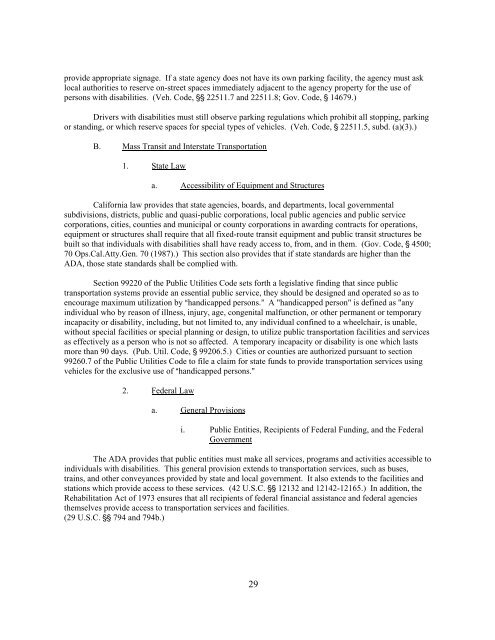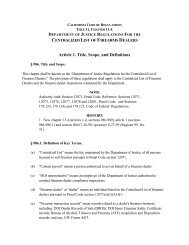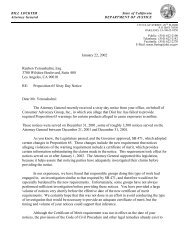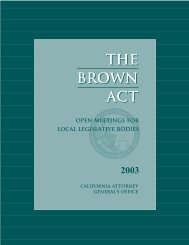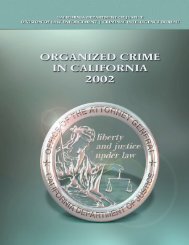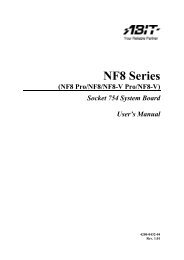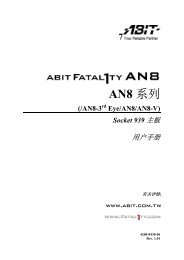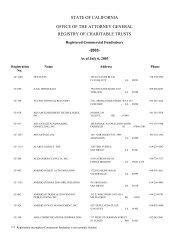Legal Rights of Persons With Disabilities - Ossh.com
Legal Rights of Persons With Disabilities - Ossh.com
Legal Rights of Persons With Disabilities - Ossh.com
Create successful ePaper yourself
Turn your PDF publications into a flip-book with our unique Google optimized e-Paper software.
provide appropriate signage. If a state agency does not have its own parking facility, the agency must ask<br />
local authorities to reserve on-street spaces immediately adjacent to the agency property for the use <strong>of</strong><br />
persons with disabilities. (Veh. Code, '' 22511.7 and 22511.8; Gov. Code, ' 14679.)<br />
Drivers with disabilities must still observe parking regulations which prohibit all stopping, parking<br />
or standing, or which reserve spaces for special types <strong>of</strong> vehicles. (Veh. Code, ' 22511.5, subd. (a)(3).)<br />
B. Mass Transit and Interstate Transportation<br />
1. State Law<br />
a. Accessibility <strong>of</strong> Equipment and Structures<br />
California law provides that state agencies, boards, and departments, local governmental<br />
subdivisions, districts, public and quasi-public corporations, local public agencies and public service<br />
corporations, cities, counties and municipal or county corporations in awarding contracts for operations,<br />
equipment or structures shall require that all fixed-route transit equipment and public transit structures be<br />
built so that individuals with disabilities shall have ready access to, from, and in them. (Gov. Code, ' 4500;<br />
70 Ops.Cal.Atty.Gen. 70 (1987).) This section also provides that if state standards are higher than the<br />
ADA, those state standards shall be <strong>com</strong>plied with.<br />
Section 99220 <strong>of</strong> the Public Utilities Code sets forth a legislative finding that since public<br />
transportation systems provide an essential public service, they should be designed and operated so as to<br />
encourage maximum utilization by Ahandicapped persons.@ A "handicapped person" is defined as "any<br />
individual who by reason <strong>of</strong> illness, injury, age, congenital malfunction, or other permanent or temporary<br />
incapacity or disability, including, but not limited to, any individual confined to a wheelchair, is unable,<br />
without special facilities or special planning or design, to utilize public transportation facilities and services<br />
as effectively as a person who is not so affected. A temporary incapacity or disability is one which lasts<br />
more than 90 days. (Pub. Util. Code, ' 99206.5.) Cities or counties are authorized pursuant to section<br />
99260.7 <strong>of</strong> the Public Utilities Code to file a claim for state funds to provide transportation services using<br />
vehicles for the exclusive use <strong>of</strong> Ahandicapped persons.@<br />
2. Federal Law<br />
a. General Provisions<br />
i. Public Entities, Recipients <strong>of</strong> Federal Funding, and the Federal<br />
Government<br />
The ADA provides that public entities must make all services, programs and activities accessible to<br />
individuals with disabilities. This general provision extends to transportation services, such as buses,<br />
trains, and other conveyances provided by state and local government. It also extends to the facilities and<br />
stations which provide access to these services. (42 U.S.C. '' 12132 and 12142-12165.) In addition, the<br />
Rehabilitation Act <strong>of</strong> 1973 ensures that all recipients <strong>of</strong> federal financial assistance and federal agencies<br />
themselves provide access to transportation services and facilities.<br />
(29 U.S.C. '' 794 and 794b.)<br />
29


